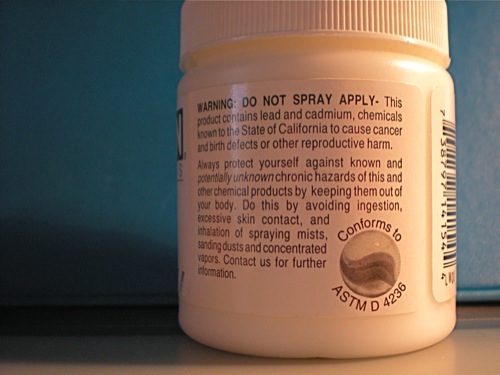
Hazard information on zinc white acrylic paint
I have a confession to make. I have a background in the chemical industry. So when I see those hazard warnings on the back of my paints I take notice. Health and safety isn't often mentioned in connection with fine arts, but we are exposed to more toxins than we may be aware of. You may know that the cadmiums are toxic but what about your other paint colors? Are they toxic? I am not saying do not use toxic paints. In fact, my research leads me to believe that would be pretty much impossible, but you should know what you are handling and take care.A little chemistry: most, but not all, of the toxicity issues are associated with heavy, or toxic, metals such as copper, cobalt, cadmium, lead. Over time these poison the body and many are known or suspected to be carcinogens. If you remember your periodic table from chemistry, these are transition metals from that central section. So a quick rule of thumb is that if there's a heavy metal in the pigment name, it's probably toxic.
Below are lists of highly toxic and moderately toxic pigments used in acrylic and oil paints, possibly in pastels and other dry media too. Since color names can be inconsistent, the pigment name follows in parentheses. The pigment used is usually listed somewhere on the tube - see photo. Also, the paint manufacturer will have Material Safety Data Sheets (MSDS) on their website. Some of the 'hue' colors contain less toxic pigments, e.g. my Cadmium Red Hue contains Toluidine Red (moderately toxic) in place of Cadmium Red (highly toxic), however it is not as opaque as a true cadmium red.

Pigment names on different brands of acrylic paint
NB This list is NOT exhaustive. I pulled up the MSDS on the Golden website to check some of my paints and was shocked to find that almost every color they manufacture has some kind of toxicity issue associated with the pigment.
After the lists are some pointers on handling your toxic paints safely. Hopefully you know and follow these already!
Update: After posting this I found a posting on art material safety by Edward Kinnally that summarizes all the standards, such as ASTM and the term "non-toxic". A very in-depth and useful resource.
Highly Toxic Pigments
- antimony white (antimony trioxide)
- barium yellow (barium chromate)
- burnt or raw umber (iron oxides, manganese silicates or dioxide)
- cadmium red, orange or yellow (cadmium sulfide, cadmium selenide)
- chrome green (Prussian blue, lead chromate)
- chrome orange (lead carbonate)
- chrome yellow (lead chromate)
- cobalt violet (cobalt arsenate or cobalt phosphate)
- cobalt yellow (potassium cobalt nitrate)
- lead or flake white (lead carbonate)
- lithol red (sodium, barium and calcium salts of azo pigments)
- manganese violet (manganese ammonium pyrophosphate)
- molybdate orange (lead chromate, lead molybdate, lead sulfate)
- naples yellow (lead antimonate)
- strontium yellow (strontium chromate)
- vermilion (mercuric sulfide)
- zinc sulfide
- zinc yellow (zinc chromate)
Moderately Toxic Pigments
- alizarin crimson
- carbon black
- cerulean blue (cobalt stannate)
- cobalt blue (cobalt stannate)
- cobalt green (calcined cobalt, zinc and aluminum oxides)
- chromium oxide green (chromic oxide)
- Phthalo blue and greens (copper phthalocyanine)
- manganese blue (barium manganate, barium sulfate)
- Prussian blue (ferric ferrocyanide)
- toluidine red and yellow (insoluble azo pigment)
- viridian (hydrated chromic oxide)
- zinc white (zinc oxide)
How to handle toxic paints safely
- Do not use the same containers for paints that you do for food or drink. Well, duh, but thought I'd put it in anyway.
- Do not put paint brushes in your mouth! Use a brush holder or a piece of kitchen towel.
- Wash hands thoroughly after each painting session.
- Even better, wear latex gloves whilst painting, or at least whilst using the toxic pigments. I hate wearing gloves but after researching this topic I will be wearing them. Simple as that.
- Wear a dust mask if you handle pigment powders. Make sure it's the right one and keep it clean!
- Do not have food in your studio and use covered drinks containers.
- Since we don't want heavy metals in our rivers either, wipe up paints with kitchen towel and dispose of in the trash, not down the drain.
- If you sand your paints at all (as an acrylic painter, yes I do) then wear a respiratory mask. Keeping the paint surface damp as you sand also keeps the dust down.




Thank you for this very informative and useful post.
ReplyDeleteTests proved I have liver damage from toxins. I use gloves regularly with pastels and oils...and now will also with the acrylics.
ReplyDeleteThank you for sharing.
Hello I am looking to use Vermilion (Mercuric Sulfide) My major question is how dangerous the paint can be AFTER it has dried...
ReplyDeleteHi Frater, I am not a toxicology expert but I believe that the paint is not dangerous once dry IF:
ReplyDelete- it is not on a surface used for food
- the dry paint surface is not sanded or scraped (which would create a dust of mercuric sulfide.)
I would expect that a coat of varnish would help protect the paint surface and also prevent damage.
Thank you for this article, Caroline. I have had it bookmarked for months now and it has been great to come back to on occasion. For Earth Day I wrote an article about how artists can make their practices more eco-friendly here: http://mypaperdaydreams.blogspot.com/2016/04/happy-earth-day-ways-to-reduce-your.html
ReplyDeleteI did include a link to your post and some of the information you have shared with accompanying credit to you (of course).
Thank you for sharing your research with us! I only hope we can get more people to be safe with their materials.